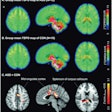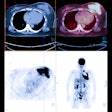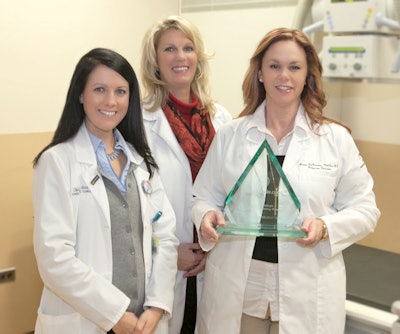
Minnies winners, page 2
Best Radiologist Training Program
Winner: Johns Hopkins University
By winning the Minnies 2015 award as Best Radiologist Training Program, Johns Hopkins University repeats an achievement it has accomplished multiple times in the 16 years of the Minnies, most recently in 2012.
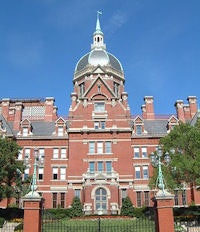
A major factor in the program's continued success is its people, dating back to Dr. Stanley Siegelman, who founded the program 30 years ago, according to Dr. Pamela Johnson, residency program director. Siegelman made resident education a department priority, a commitment continued by Dr. Karen Horton, who led the residency program for the past five years until Johnson took over in March 2014, as well as Dr. Jonathan Lewin, who leads the overall radiology program.
The program's faculty members are all leaders in their respective fields and have a passion for educating and mentoring young radiologists, Johnson said. A major priority of the program is teaching residents how to perform the most appropriate imaging exam for every patient to add value to the care process.
"That is the model for a successful radiologist in the future: You have to be an active member of the patient care team," Johnson said.
Despite its illustrious pedigree, Johns Hopkins isn't resting on its laurels, and it's adopting new IT-driven tools to advance resident education even further. After a year of development, the department in July rolled out a new dashboard designed to give residents real-time feedback on how well they are doing, both relative to their class, by comparing them to deidentified data from their classmates, and compared to a range of clinical and professional metrics.
For example, the dashboard includes data on case volumes, and the rates at which residents' case interpretations undergo modifications after the fact, as well as other education milestones set by the Accreditation Council for Graduate Medical Education (ACGME). Residents can use the dashboard to find out what areas they need work on, and data are pulled in real-time, so they don't have to wait until the end of the month.
The dashboard represents a huge change in graduate medical education, and it's been positively received by residents at Hopkins, Johnson said. The program is using the first year to collect aggregate data on resident performance, which could then be used to set benchmarks, such as for case interpretation volumes, in the second year.
In other projects, Johns Hopkins is developing more advanced fourth-year electives, as well as a diagnostic radiology/interventional radiology (DR/IR) track that includes IR training in the first year and a combination radiology/nuclear medicine track, Johnson said.
Runners-up: Stanford University, Stanford, CA; University of California, San Francisco, San Francisco, CA
(Two candidates tied for second place in this category)
Best Radiologic Technologist Training Program
Winner: Albert Einstein Medical Center, Philadelphia, PA
This year's winner of the Best Radiologic Technologist Training Program, Albert Einstein Medical Center, was faced with a difficult decision when the economy went south back in 2008. The job market for radiologic technologists in the Philadelphia area had contracted dramatically, but RT training programs continued to pump out graduates, making it extremely difficult for newly minted technologists to find jobs.
So Albert Einstein, which had been training RTs for more than 60 years, put its program on hiatus rather than continue to send graduates into the workforce without good job prospects, according to Linda DeRenzis, director of the radiologic technology program. It was a particularly tough decision for DeRenzis, who herself had gone through the program in 2000 before becoming director in 2009.
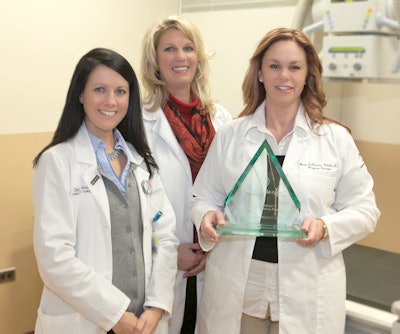 Linda DeRenzis (right) and colleagues at Albert Einstein Medical Center.
Linda DeRenzis (right) and colleagues at Albert Einstein Medical Center."It was emotionally hard for me," DeRenzis said. "It was a home for me, and to see things potentially come to a close was very upsetting."
Fast forward two years: The technologist job market in Philadelphia began rebounding, so Albert Einstein reopened the program in 2013. In May, the program graduated its first class since restarting, and DeRenzis reports that so far its graduates have a 100% job placement rate. She believes that the decision to put things on hiatus probably was a major factor in helping the Philadelphia market for technologists return to equilibrium.
"Instead of worrying about making money for the program, we were worried about what would happen for our graduates," DeRenzis said.
Albert Einstein graduated 16 technologists in its most recent class. Thanks to a partnership with Philadelphia University, graduates have an Associate of Sciences degree when they complete the program.
DeRenzis advises technologists entering the workforce to be flexible, given the still-turbulent job market. Full-time positions can still be hard to find, but there are a number of part-time and per diem positions that can evolve into permanent jobs, especially as members of the baby boom generation retire.
And always remember to be assertive.
"Be an advocate for yourself," she advises.
Runner-up: University of Iowa, Iowa City, IA
Most Significant News Event in Radiology
Winner: CMS approves CT lung cancer screening for smokers
No big surprise in this category, as the approval of Medicare payments for CT lung cancer screening in November 2014 has been easily the biggest radiology story of the past year. The move ushers in a broad-based screening program that has the potential to save the lives of thousands of current and former smokers.
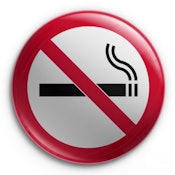
But getting approval for CT screening was never a slam dunk. The march to reimbursement started off well, with the publication in 2010 of results from the National Lung Screening Trial (NLST), which found that CT screening reduced mortality by more than 20% in a high-risk group of smokers. In 2013, the U.S. Preventive Services Task Force (USPSTF) also signed off on the exam, giving it a grade B recommendation.
But things hit a snag in April 2014, when a Medicare advisory panel held a largely negative meeting that left screening proponents stunned. The panel raised objections about radiation dose, false positives, and other "harms" of screening that many felt had already been resolved.
What followed were six months of nervous waiting as the U.S. Centers for Medicare and Medicaid Services (CMS) pondered the data. Ultimately, CMS ruled against its own advisory panel and in favor of paying for scans of individuals at high risk of lung cancer, mostly current and former smokers.
Since then, most of the debate over CT lung cancer screening has been over exactly which individuals should be considered eligible. The NLST criteria were relatively conservative, including a limitation that an individual must have smoked for 30 pack-years or more. But what about those with 20 or 25 years of smoking history? Or people with complicating conditions such as chronic obstructive pulmonary disease?
Debate has also raged over the economic costs of screening, as well as the clinical implications of following up false positives -- which were on the high side in NLST. And there are even unintended consequences to consider, as implied by an August study in JAMA Internal Medicine that found that some smokers may interpret a clean CT scan as a green light to keep on smoking.
But in the months to come, the radiology community is sure to address many of these concerns, using tools such as the Lung-RADS system for handling suspicious findings or computer-aided detection (CAD) software to help radiologists deal with the deluge of screening scans.
Runner-up: New digital breast tomosynthesis systems arrive on U.S. market
Biggest Threat to Radiology
Winner: Commoditization of radiology services
For the second year running, radiology's growing trend toward commoditization was named the Biggest Threat to Radiology by the Minnies expert panel.

The fact that the topic has repeated in consecutive years indicates the existential threat that commoditization is believed to represent to radiology's traditional business model in the U.S. Meanwhile, the federal government's shift toward value-based payment systems offers either a magnification of the threat or a potential way out of the morass, depending on your point of view.
A confluence of factors has led to commoditization, including the rise of the teleradiology industry, ongoing reimbursement cuts, and a shift of control over outpatient imaging from independent centers to hospitals. Hospital administrators now hold most of the cards, and they can call the tune to which radiology practices must dance.
But the picture isn't all doom and gloom. The commoditization problem has been recognized at radiology's highest levels, and it's being addressed through initiatives such as the Imaging 3.0 program by the American College of Radiology, which aims to give radiologists tools to recognize and adapt to the changing healthcare environment, such as the move toward value-based care.
What are some ways that radiologists can adapt to the new environment? Good lines of communication with hospital administration are key, and gone are the days that radiology practices can dictate terms to hospital clients. You can even consider comanagement strategies in which the hospital and radiology group manage radiology services.
Also try to align your practice with your hospital's strategic direction. Figure out ways to help hospitals achieve their goals, whether it's improving care quality or shortening patients' length of stay.
And definitely take advantage of opportunities to learn about emerging value-based care models, such as at the upcoming RSNA 2015 meeting (see "Most Effective Radiology Educator," page 1).
As noted by Dr. Jonathan Berlin of the University of Chicago in a talk earlier this year, the opposite of commodity is value. Find a way to add value to the services you offer, and you'll begin to rise above the commoditized crowd.
Runner-up: Shift of radiology reimbursement away from fee-for-service model
Hottest Clinical Procedure
Winner: CT lung cancer screening
For five years running, digital breast tomosynthesis (DBT) was named the Hottest Clinical Procedure by the Minnies expert panel. This year, DBT's reign finally ended, with the panel picking CT lung cancer screening for the top spot.
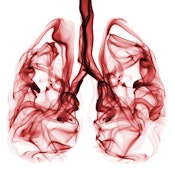
It's not hard to see why. The decision by CMS in November 2014 to approve Medicare payments for CT screening dramatically altered the radiology landscape, creating a new population-based screening program for the first time in years (see "Most Significant News Event in Radiology," above).
With the CMS imprimatur in hand, the hard work begins for radiologists: actually screening people. Initially, most scans will be limited to those covered by the CMS criteria -- namely, current or former smokers with 30-pack-year histories of smoking. A major challenge will be educating referring physicians such as pulmonologists about the eligibility criteria so they can refer patients appropriately.
It's also likely that there will be disagreements over which lung nodules are considered suspicious for cancer and should be worked up. CT screening facilities are going to have to strike a balance between sensitivity in detecting cancer and specificity by not working up too many nodules that turn out to be benign.
This last point hints at a harbinger of things to come, if the ongoing controversy over mammography is any guide. Skeptics of population-based screening programs have already begun raising questions about issues such as overdiagnosis and the harms of screening with respect to CT screening -- issues that have bedeviled breast screening for decades. Proponents of CT screening should begin preparing their counterarguments now, or be prepared for a long fight.
Runner-up: Cardiac CT angiography




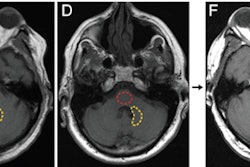
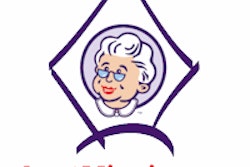
![2014 09 18 16 10 38 871 2014 09 15 15 01 18 28 Rsna Logo[1]](https://img.auntminnie.com/files/base/smg/all/image/2015/10/am.2014_09_18_16_10_38_871_2014_09_15_15_01_18_28_RSNA-logo[1].png?auto=format%2Ccompress&fit=crop&h=167&q=70&w=250)

